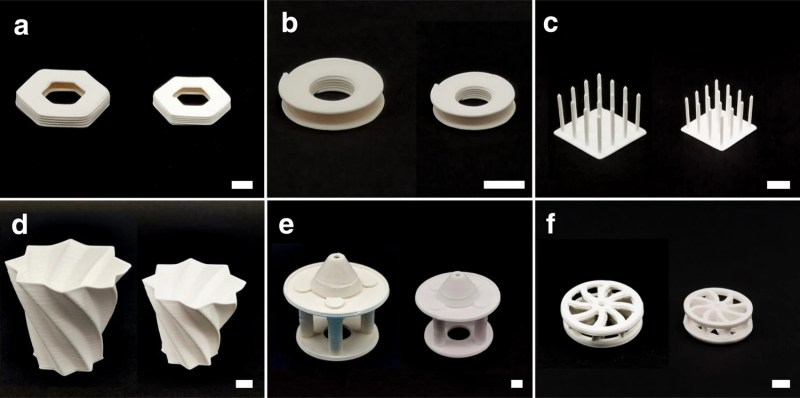3D printing is at its most accessible (and most affordable) when printing in various plastics or resin. Printers of this sort are available for less than the cost of plenty of common power tools. Printing in materials other than plastic, though, can be a bit more involved. There are printers now for various metals and even concrete, but these can be orders of magnitude more expensive than their plastic cousins. And then there are materials which haven’t really materialized into a viable 3D printing system. Ceramic is one of those, and while there are some printers that can print in ceramic, this latest printer makes some excellent strides in the technology.
Existing technology for printing in ceramic uses a type of ceramic slurry as the print medium, and then curing it with ultraviolet light to solidify the material. The problem with ultraviolet light is that it doesn’t penetrate particularly far into the slurry, only meaningfully curing the outside portions. This can lead to problems, especially around support structures, with the viability of the prints. The key improvement that the team at Jiangnan University made was using near-infrared light to cure the prints instead, allowing the energy to penetrate much further into the material for better curing. This also greatly reduces or eliminates the need for supports in the print.
The paper about the method is available in full at Nature, documenting all of the details surrounding this new system. It may be a while until this method is available to a wider audience, though. If you can get by with a print material that’s a little less exotic, it’s not too hard to get a metal 3D printer, as long as you are familiar with a bit of electrochemistry.

















If you want to ensure the fired ceramic 3D print is non-porous, apply a coating of glaze to it then fire it after firing the 3D print the first time. Do not just dunk the item in a tub of liquid glaze. Brush on just enough to fully coat or thin the glaze with water and spray it with an airbrush.
The simplest and easiest glaze is clear, often called clear brushing. Since the clay used for most slip casting in plaster molds fires to a bright white, clear glaze is commonly used to coat the interiors of ceramic vessels like pitchers and vases. Pour in some glaze, roll it around to coat everything. Pour out most of the glaze then set the item on its side for around 30 seconds, then pour out again, keeping the same side down. Keep the item inverted until glaze stops dripping out. Then you can return the item to upright.
The same trick should be used when doing the slip casting. When it’s time to pour out the excess slip, don’t just tip the mold upside down and leave it to drain. You’ll get drip bumps in the bottom. Dump it, lay it down long enough for the liquid slip to run sideways off the flat inside bottom, then tip upside down to finish draining. One of our competitors in the 1970’s and 1980’s ceramics business didn’t do that so her greenware and bisque vessels always had bumps in the bottom. My parents told her how to not have those but she refused to change from just tipping the molds directly upside down to drain.
and when the part goes through consolidation? What happens to the escaping polymer gases when they reach this slip cocoon youve trapped them in? You do understand that a photopolymer/ceramic particle slurry is entirely different from watering down your clay to make it sloppy? 3d printed ceramics via filament deposition, or UV cure share more in common with Powder Metallurgy techniques like MIM than your mommas coffee mug and vase obsession.
Could an ultrasonic extruder be used to work with almost dry clay?
clay ultrasound liquefaction?
https://www.amazon.com/Polyolefin-Clay-nanocomposites-prepared-aid-ultrasound/dp/3639516907
Ceramic type materials are naturally brittle, this will limit their posible use cases. Compressive forces will be fine, but any shocks or jolts are going to shatter them.